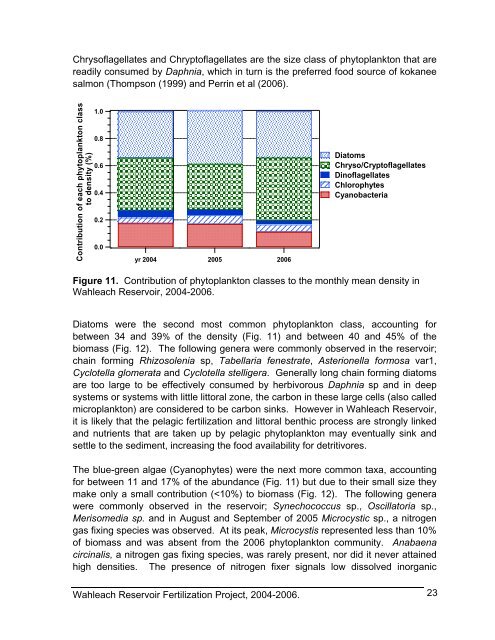Wahleach Project Water Use Plan Wahleach Reservoir ... - BC Hydro
Wahleach Project Water Use Plan Wahleach Reservoir ... - BC Hydro
Wahleach Project Water Use Plan Wahleach Reservoir ... - BC Hydro
Create successful ePaper yourself
Turn your PDF publications into a flip-book with our unique Google optimized e-Paper software.
Chrysoflagellates and Chryptoflagellates are the size class of phytoplankton that are<br />
readily consumed by Daphnia, which in turn is the preferred food source of kokanee<br />
salmon (Thompson (1999) and Perrin et al (2006).<br />
Contribution of each phytoplankton class<br />
to density (%)<br />
1.0<br />
0.8<br />
0.6<br />
0.4<br />
0.2<br />
0.0<br />
yr 2004 2005 2006<br />
Diatoms<br />
Chryso/Cryptoflagellates<br />
Dinoflagellates<br />
Chlorophytes<br />
Cyanobacteria<br />
Figure 11. Contribution of phytoplankton classes to the monthly mean density in<br />
<strong>Wahleach</strong> <strong>Reservoir</strong>, 2004-2006.<br />
Diatoms were the second most common phytoplankton class, accounting for<br />
between 34 and 39% of the density (Fig. 11) and between 40 and 45% of the<br />
biomass (Fig. 12). The following genera were commonly observed in the reservoir;<br />
chain forming Rhizosolenia sp, Tabellaria fenestrate, Asterionella formosa var1,<br />
Cyclotella glomerata and Cyclotella stelligera. Generally long chain forming diatoms<br />
are too large to be effectively consumed by herbivorous Daphnia sp and in deep<br />
systems or systems with little littoral zone, the carbon in these large cells (also called<br />
microplankton) are considered to be carbon sinks. However in <strong>Wahleach</strong> <strong>Reservoir</strong>,<br />
it is likely that the pelagic fertilization and littoral benthic process are strongly linked<br />
and nutrients that are taken up by pelagic phytoplankton may eventually sink and<br />
settle to the sediment, increasing the food availability for detritivores.<br />
The blue-green algae (Cyanophytes) were the next more common taxa, accounting<br />
for between 11 and 17% of the abundance (Fig. 11) but due to their small size they<br />
make only a small contribution (
















